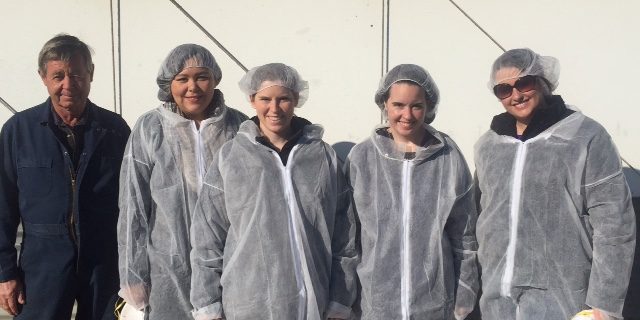My internship with the Alliance is coming to an end, and I’m sad to leave no matter how great South Florida temperatures are sounding right now! I’ve learned so much during my time here – not only about animal agriculture but about life in general. I think that the number one life lesson I’ll be taking back to Florida with me is this: no matter what the situation is, I need to look into things myself and form my own opinions before accepting what I read and hear as fact.
Throughout my internship with the Alliance, I’ve had the privilege of visiting several farms. I was able to tour both the pork adventure and the dairy adventure at Fair Oaks Farms in Fair Oaks, Indiana. A major poultry company’s employees were kind enough to give me and some of my coworkers a tour of one of their hatcheries as well as two chicken farms. I was also lucky enough to visit an Angus beef cattle farm and a sheep farm. Through these experiences, I have gotten an opportunity to collect an understanding of the way modern animal agriculture really looks. I’m more than happy to share with you the things I’ve learned along the way:
Some things may look confusing if you don’t have the context behind science-based practices.
Like I’ve mentioned before, I went into this internship without any experience in animal agriculture. I would be considered a typical consumer. I’ve learned that the first step in creating a better understanding of animal agriculture is for us as consumers to be aware that we do not know everything about the industry – and with such a broad and diverse industry, it would be hard for anyone to! Farmers make up only 2% of the population in America and many of us are removed from agriculture by several generations. It’s not a bad thing, it just means that we might need some additional information for us to fully understand what and why farmers do certain things.
For example, if someone posted a picture of broiler chickens (chickens raised for meat) claiming that they are raised in crowded barns, we might believe that chickens are raised without the space they need to roam and be comfortable. A closer look into the truth reveals that experts with the Council for Agricultural Science and Technology (CAST) have conducted studies and found that broiler chickens need a minimum of one-half square foot per bird. Typical chicken barns, however, allow eight-tenths of a square foot per bird. Chickens have a flocking mentality, which means that they like to be in close proximity to one another. So, while some may claim broiler chickens are raised in overcrowded conditions, the truth is that the birds are given more than the necessary space they need and they group together out of preference.
This is only one example. More than likely, there are management practices that consumers might not understand at first glance in every species-specific part of animal agriculture. Farmers rely on science-based practices to take the best care of their animals and many farmers (like the ones I met!) are more than happy to explain why they do what they do – we just need to ask.
Farmers are passionate about what they do.
Farmers are passionate about their work. That’s something that I was able to witness first-hand. It was easy for me to tell just by studying their
faces that they were proud of their workplaces and were happy to have visitors look around at the results of their hard work. When one of us asked a particular farmer why he has chosen to continue raising chickens over the years, he smiled and happily answered, “We just like raising chickens.” If you had met the Angus beef cattle farmer that I met, there would be no doubt in your mind that he is passionate about what he does. The sheep farmer that showed us around his farm was equally passionate about his animals. It stood as a common theme throughout my farm tours, and it’s something I’ll remember for a long time.

Farmers want to do their job well and provide the best care for their animals.
Farmers want to treat their animals well not only because it’s their passion, but also because it’s their business. This requires farmers to build relationships with the animals they raise. We had a lot of discussion while touring farms, most of which centered around animal care. One thing that really struck me was that when we asked questions like “How do you know what to do to make the animals the most comfortable?” several different farmers would say something to the effect of “They’ll tell me what they need.” In order to build this kind of intimacy with the animals they raise, farmers spend a lot of time with them studying their behaviors. Good animal management pays farmers back in more ways than one. Well cared for animals are not only the pride of the farmer, but also create a better market and a happier consumer.
After getting a behind-the-scenes look, I feel confident that the animal products I eat are a result of responsible animal care and a farmer’s careful attention.
I know that people are becoming more and more interested in the food they eat and where it came from, and that is a wonderful thing! After getting an inside look into the world of animal agriculture, I can say that I feel comfortable eating the burgers, pork chops, eggs, milk, chicken and turkey I love. I hope my story and experience encourages you to ask your own questions and form your own opinions. I will say that after finding my own answers, I’m confident that you’ll be pleased with what you learn as well!
All posts are the opinion of the author and do not necessarily represent the view of the Animal Ag Alliance.








